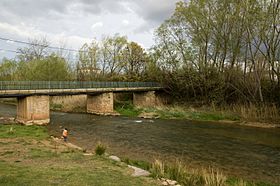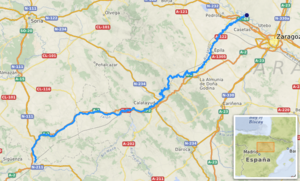Jalón (river) facts for kids
Quick facts for kids Jalón |
|
|---|---|

The river Jalón in Terrer, Zaragoza (province).
|
|

Path of the Jalón river [1]
|
|
| Country | Spain |
| Physical characteristics | |
| Main source | Esteras de Medinaceli Medinaceli, Iberian System, Castile and León 1,192 m (3,911 ft) 41°05′34″N 2°25′28″W / 41.092762°N 2.424388°W |
| River mouth | Ebro Torres de Berrellén, Zaragoza, Aragón 209 m (686 ft) 41°46′39″N 1°03′46″W / 41.777476°N 1.062856°W |
| Length | 224 km (139 mi) |
| Depth |
|
| Basin features | |
| Progression | Ebro→ Mediterranean Sea |
| Basin size | 9,338 km2 (3,605 sq mi) |
| Tributaries | |
| River system | Ebro |
The Jalón River is an important river in the northeast of Spain. It is one of the main tributaries (smaller rivers that flow into a larger one) of the Ebro River. The Jalón is about 224 kilometres (139 mi) long. Its basin, which is the area of land where all the water drains into the river, covers about 9,338 square kilometres (3,605 sq mi).
The amount of water flowing in the Jalón River can change a lot. This is because the weather in the Mediterranean region has very different rainfall patterns. For a long time, the path of the Jalón River was a key route. Roads and railways between Madrid and Zaragoza followed this river valley until the late 1900s.
Contents
Where the Jalón River Flows
River's Beginning and Early Journey
The Jalón River starts from springs at the bottom of the Sierra Ministra hills. This is near Esteras de Medinaceli in Medinaceli, which is in the province of Soria.
From there, the river flows through places like Arcos de Jalón. It then enters the province of Zaragoza in Aragón, passing through Monreal de Ariza.
Middle Part of the River
As the Jalón continues, other rivers join it. The Nágima River meets the Jalón at Monreal de Ariza. Then, the Henar River joins at Cetina. After this, the Jalón flows into a deep, narrow valley called a limestone gorge near Alhama de Aragón.
The river then winds its way through the Iberian Mountain Range near Bubierca. Here, two more rivers, the Piedra and the Manubles, add their waters at Ateca.
River's End and Joining the Ebro
When the Jalón reaches Calatayud, the valley gets much wider. Here, it is joined by the Jiloca, Perejiles, and Ribota rivers. The next part of its journey takes it winding through the Sierra de Algairén and the Sierra de la Virgen mountains.
After leaving the mountains, the Jalón River enters the wide valley of the Ebro River. The Aranda, Grío, and Alpartir rivers join it before the Jalón finally flows into the Ebro River itself. This happens at Torres de Berrellén, which is a town near the city of Zaragoza.
Animals and Nature Along the Jalón
Protecting Wildlife
A large part of the Jalón River's path is a special protected area for birds. This is called a Special Zone for Bird Protection. Many different kinds of birds live here.
Birds and Other Animals
You can find powerful birds like falcons, eagles, and vultures flying above the river. Smaller birds like owls and wrens also live here, along with herons that stand in the water.
Plants and Fish Life
Along the riverbanks, you'll see trees like poplar, willow, and ash. In the past, fish like carp, trout, and eels were very important for the local economy. As efforts to reduce pollution have improved, these fish are starting to return to the river.
River Management Plan
To help manage and protect the river, a plan called the Plan Hidrológico del río Jalón was created. This river management plan was put into action in 2007 by the Spanish government and the governments of the regions of Aragon, Castile and León, and Castile-La Mancha.
What "Jalón" Means
The name "Jalón" comes from a very old European word for rivers. Experts believe it comes from an ancient language called Indo-European. The root word *sal- meant 'flowing water' or 'stream'.
See also
 In Spanish: Río Jalón para niños
In Spanish: Río Jalón para niños

